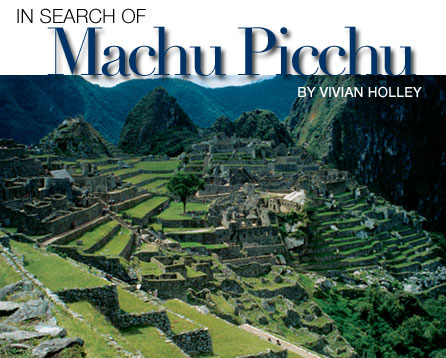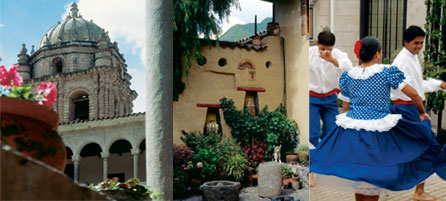| |

ABOVE: MACHU PICCHU, THE "LOST CITY" OF THE MIGHTY
INCA EMPIRE, RISES HIGH ON A MOUNTAINTOP IN THE PERUVIAN ANDES.
"...great
snow peaks looming above the clouds...orchids and tree ferns...the
mysterious witchery of the jungle..."
– Hiram Bingham, “Lost City of the Incas”
Small wonder that Hiram Bingham’s account of his discovery
of otherworldly Machu Picchu sometimes takes a poetic turn. And
these words from Bingham’s book describe only the setting of
the jewel of the Peruvian Andes. More splendid by far is the treasure
itself, a wondrous relic of the mighty Inca Empire that once ruled
an Andean expanse reaching from Columbia to Chile.
 It
was a city dedicated to the sun–a sanctuary for the priests
and virgins who served the sun god. Though it’s a mere 43 miles
from the Inca capital of Cusco, the conquering Spanish made no mention
of it, and the Incas had no written language for leaving a record.
The storied, steep-terraced site remained a secret for centuries,
serenely hidden high above the roar of the Urubamba River, wrapped
in a tangle of tropical vegetation and protected by emerald peaks. It
was a city dedicated to the sun–a sanctuary for the priests
and virgins who served the sun god. Though it’s a mere 43 miles
from the Inca capital of Cusco, the conquering Spanish made no mention
of it, and the Incas had no written language for leaving a record.
The storied, steep-terraced site remained a secret for centuries,
serenely hidden high above the roar of the Urubamba River, wrapped
in a tangle of tropical vegetation and protected by emerald peaks.
The secret was unveiled in 1911 when Bingham, a Yale explorer-archaeologist
and something of an Indiana Jones, ventured up a steep hill and
stumbled onto the fabled citadel that beckons visitors today.

ABOVE (L-R): IN HISTORY-RICH CUSCO, THE SPANISH RAISED THEIR
STRUCTURES ON THE FOUNDATIONS OF THE INCA CAPITAL; A CHARMING COURTYARD
IN THE SACRED VALLEY; THE ATTRACTIONS OF LIMA, THE COUNTRY'S PULSATING
CAPITAL, RANGE FROM ANTIQUE ARCHITECTURE TO VIBRANT NIGHTLIFE.
Constructed over more than half a century beginning about 1450,
historians say, Machu Picchu’s parts are connected by seemingly
countless stone steps that lead to the likes of the Temple of the
Sun, the Temple of the Three Windows, and the Intihuatana –
a strategically-positioned block of stone that some call “the
hitching post of the sun,” used in the planning of spiritual
ceremonies and seasonal celebrations. Particularly astonishing is
the precision of the stonework that sculpted some 200 structures
– architecture that blends seamlessly and artfully into the
spectacular natural surroundings.
Most Machu Picchu-bound travelers fly into Lima, journey on to imperial
Cusco, and take a train to the site. Orient-Express, an expanding
presence in Peru, serves up handsome accommodations at its stunning
Miraflores Park Hotel in Lima. It overlooks the Pacific beaches
of the chic Miraflores district, base for the pulsating city’s
hottest restaurants and nightspots. In Cusco, the company’s
charming Hotel Monasterio was constructed in the 16th century as
a Spanish monastery, on the site of a onetime Inca palace. A boon
for newly-arrived vacationers adjusting to the city’s perch
at 11,000 feet above sea level: the recent addition of oxygen concentrators
to most of the guestrooms.
Late last year Orient-Express whipped a major component into the
maximum-comfort mix. Now linking Cusco to Machu Picchu is the aptly-christened
Hiram Bingham luxury train operated by PeruRail, a notable upgrade
in the train service offered along this route. The 84-passenger
train re-creates the style of the 1920s Pullman era with its painstakingly
restored Victorian rail cars–a bar car with observation deck,
and a pair of dining cars that present a tasty champagne brunch
on the outbound trip, an elegant dinner with excellent wines on
return.
The company’s comfortably rustic Machu Picchu Sanctuary Lodge
– the only hotel within the storied Inca site – is only
a few steps from the entrance to the ruins, which makes for easy
explorations at any hour.
Once lost, now found Machu Picchu should be visited when shrouded
by mist in the morning, when bathed in its sun-god glory at midday,
and when magically lit by the moon. It’s an experience a traveler
is not likely to forget.
Information: (800) 237-1236 or www.orient-express.com.
|
|
|



